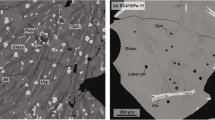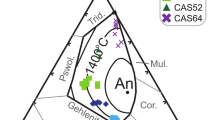Abstract
Many lamprophyre dike and sill rocks in the Monteregian Hills petrographic province of southwestern Quebec contain felsic segregations (ocelli) which have been interpreted as globules of immiscible liquid (Philpotts 1976). Ocelli and matrix material were separated from a number of these rocks and analyzed for major and trace elements. The major element data, when plotted on a Greig diagram, outline a field of possible silicate-liquid immiscibility at higher alumina+alkali content than that previously mapped in iron-rich experimental systems. The trace element data support a liquid immiscibility hypothesis for the formation of these ocelli since high-charge density cations are preferentially concentrated in the matrix (mafic) material, a result which is consistent with theoretical and experimental studies.
The distribution of minor and trace elements between ocelli and matrix indicates that several factors control the partitioning of these elements between immiscible felsic and mafic liquids. These factors include the difference in relative polymerization (as measured by the Si∶O ratio) of the two liquids, with an increase in this difference favoring partitioning of the high-charge density cations into the mafic liquid; the concentration of P2O5 in the mafic liquid which favors the partitioning of high-charge density cations into this liquid; the presence of a CO2 vapor (?) phase which favors the partitioning of high-charge density cations into the CO2 enriched phase; and the presence of solid phases at the onset of immiscibility. These observations indicate that the chemical compositions of two possibly immiscible melts should be known if minor and trace element data are to be used as evidence for silicate-liquid immiscibility.
Similar content being viewed by others
References
Bernas B (1968) A new method for decomposition and comprehensive analysis of silicates by atomic absorption spectrometry. Anal Chem 40:1682–1686
Eby GN (1979) Mount Johnson, Quebec-an example of silicate liquid immiscibility? Geology 7:491–494
Ferguson J, Currie KL (1971) Evidence of liquid immiscibility in alkaline ultrabasic rocks at Callander Bay, Ontario. J Petrol 12:561–585
Freestone IC (1978) Liquid immiscibility in alkali-rich magmas. Chem Geol 23:115–123
Herzberg CT (1979) The solubility of olivine in basaltic liquids: an ionic model. Geochim Cosmochim Acta 43:1241–1251
Hess PC, Rutherford MJ (1974) Element fractionation between immiscible melts (abstr). Lunar Sci 5:328–330
Irvine TN (1975) The silica immiscibility effect in magmas. Carnegie Inst Washington Yearb 74:484–492
Philpotts AR (1971) Immiscibility between feldspathic and gabbroic magmas. Nature (London), Phys Sci 229:107–109
Philpotts AR (1972) Density, surface tension and viscosity of the immiscible phase in a basic alkaline magma. Lithos 5:1–18
Philpotts AR (1976) Silicate liquid immiscibility: its probable extent and petrogenetic significance. Am J Sci 276:1147–1177
Philpotts AR, Hodgson CJ (1968) Role of liquid immiscibility in alkaline rock genesis. 23rd Int Geol Congress, Prague 2:175–188
Philpotts JA, Schnetzler CC, Philpotts AR (1970) Monteregian mixed rocks. Geol Soc Am Abstr Prog 2:652–653
Roedder E (1951) Low temperature liquid immiscibility in the system K2O-FeO-Al2O3-SiO2. Am Mineral 36:282–286
Roedder E (1979) Silicate liquid immiscibility in magmas. In: HS Yoder Jr (ed) The Evolution of the Igneous Rocks. Princeton University Press, Princeton, pp 15–57
Ryerson FJ, Hess PC (1978) Implication of liquid-liquid distribution coefficients to mineral-liquid partitioning. Geochim Cosmochim Acta 42:921–932
Watson EB (1976) Two liquid partition coefficients: experimental data and geochemical implications. Contrib Mineral Petrol 56:119–134
Watson EB (1977) Partitioning of manganese between forsterite and silicate liquid. Geochim Cosmochim Acta 41:1363–1374
Wendlandt RF, Harrison WJ (1979) Rare earth partitioning between immiscible carbonate and silicate liquids and CO2 vapor: results and implications for the formation of light rare earth-enriched rocks. Contrib Mineral Petrol 69:409–419
Wilson AD (1955) A new method for the determination of ferrous iron in rocks and minerals. Bull Geol Surv GB 9:56–58
Author information
Authors and Affiliations
Rights and permissions
About this article
Cite this article
Eby, G.N. Minor and trace element partitioning between immiscible ocelli-matrix pairs from lamprophyre dikes and sills, Monteregian Hills petrographic province, Quebec. Contr. Mineral. and Petrol. 75, 269–278 (1981). https://doi.org/10.1007/BF01166767
Received:
Accepted:
Issue Date:
DOI: https://doi.org/10.1007/BF01166767




